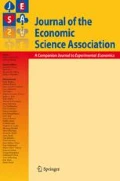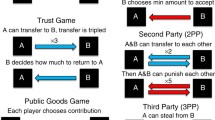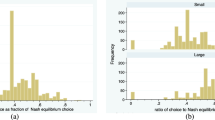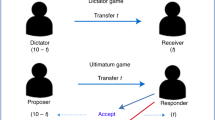Abstract
Cooperation motives are traditionally elicited in experimental games where players have misaligned interests that yield noncooperation in equilibrium. Research finds a typology of behavioral types such as free riders and conditional cooperators. However, intrinsic motives in conflict settings such as appeasement, punishment, and greed are elusive in such games where noncooperation is the equilibrium prediction. To identify types in the dark side of human interaction, we apply hierarchical cluster analysis to data from the Vendetta Game, which has a payoff structure similar to public goods games but a dynamic move structure that yields cooperation in equilibrium. It allows us to observe diverse non-equilibrium conflict strategies, and to understand how feuds perpetuate. We relate our method and typology to other social dilemmas.

Similar content being viewed by others
Notes
We use session averages as the unit of independent observation for these non-parametric tests to control for the non-independence of observations within each session.
We do not use decisions when a player is disadvantaged but cannot steal more than the equilibrium amount (typically when the state of the game is one step away from the terminal point), or when one is equal/advantaged and the co-player has nothing left to steal (cannot play Greed). Four subjects were unclassifiable because they were either never disadvantaged or never equal/advantaged.
There are many alternatives to our method, which we have chosen because of its simplicity and transparency. In addition to pure data mining methods, clustering can be carried out with respect to the parameters of a game theoretic model (e.g., Bolle et al. 2012). Our analysis distinguishes between disadvantaged or equal/advantaged states which are derived from game theoretic equilibrium analysis and are equality oriented.
Comparisons between Sharks and Non-Sharks use independent session-level means, while comparisons between Sharks and other types match individual-level emotions. Table 3 shows no contradiction between the evaluation methods.
In experiments with a stranger design (random matching in every round), players may adapt to average behavior in the population but cannot reply to the behavior of a specific opponent as in the VG.
Analyzing decisions in the HDL and the HDH separately, only 30 and 32 of the 86 subjects can be characterized by applying a cluster analysis. Therefore, although behavior in the two games differ, we analyze them jointly.
This may be implemented by a mixed Markov strategy or by an algorithm of switching after a number of rounds. Such strategies are more sophisticated than the simple Markov strategies found in the VG.
We compute C-Lasso using the MATLAB code of Shi Zhentao (https://github.com/zhentaoshi/C-Lasso). Our linear probability model captures the sequence of moves with four Markov states, controls for HDH and round, and selects two groups. Group 2 estimates for S1–S4 (0.99, 0.50, 0.76, 0.48) are compatible with Stayers, and others including Meeks and TfTs are captured by Group 1 (0.92, 0.66, 0.44, 0.55); all coefficients are significant at p < 0.0001. Group 1 contains 8 of 11 Meeks and 8 of 9 TfTs while Group 2 contains 22 of 30 Stayers. Thus, 76.5% of hierarchical cluster types are consistently grouped by C-Lasso.
References
Blanco, M., Engelmann, D., & Normann, H. T. (2011). A within-subject analysis of other-regarding preferences. Games and Economic Behavior, 72(2), 321–338.
Bolle, F., Breitmoser, Y., Heimel, J., & Vogel, C. (2012). Multiple motives of pro-social behavior: Evidence from the solidarity game. Theory and Decision, 72(3), 303–321.
Bolle, F., Tan, J. H. W., & Zizzo, D. J. (2014). Vendettas. American Economic Journal: Microeconomics, 6, 93–130.
Bordt, S., Helmut, F., & Kögel, H. 2019. Estimating grouped patterns of heterogeneity in repeated public goods experiments. Working paper.
Bosman, R., & Van Winden, F. (2002). Emotional hazard in a power-to-take experiment. The Economic Journal, 112(476), 147–169.
Bowles, S., & Gintis, H. (2004). The evolution of strong reciprocity: Cooperation in heterogeneous populations. Theoretical Population Biology, 65(1), 17–28.
Cappelen, A. W., Konow, J., Sørensen, E. Ø., & Tungodden, B. (2013). Just luck: An experimental study of risk-taking and fairness. American Economic Review, 103(4), 1398–1413.
Charness, G., & Rabin, M. (2002). Understanding social preferences with simple tests. The Quarterly Journal of Economics, 117(3), 817–869.
Chaudhuri, A. (2011). Sustaining cooperation in laboratory public goods experiments: A selective survey of the literature. Experimental Economics, 14(1), 47–83.
Chowdhury, S. M., & Gürtler, O. (2015). Sabotage in contests: A survey. Public Choice, 164(1–2), 135–155.
Crawford, V. P., & Iriberri, N. (2007). Fatal attraction: Salience, naivete, and sophistication in experimental “hide-and-seek” games. American Economic Review, 97(5), 1731–1750.
Dal Bó, P., & Fréchette, G. R. (2011). The evolution of cooperation in infinitely repeated games: Experimental evidence. American Economic Review, 101(1), 411–429.
Dal Bó, P., & Fréchette, G. R. (2018). On the determinants of cooperation in infinitely repeated games: A survey. Journal of Economic Literature, 56(1), 60–114.
Davidson, M. N., & Greenhalgh, L. (1999). The role of emotion in negotiation: The impact of anger and race. Research on Negotiation in Organizations, 7, 3–26.
Davies, D. L., & Bouldin, D. W. (1979). A cluster separation measure. IEEE Transactions on Pattern Analysis and Machine Intelligence, 2, 224–227.
Dickinson, D. L., & Masclet, D. (2015). Emotion venting and punishment in public good experiments. Journal of Public Economics, 122, 55–67.
Dunn, C. J. (1973). A fuzzy relative of the ISODATA process and its use in detecting compact well-separated clusters. Journal of Cybernetics, 3(3), 32–57.
Elster, J. (1998). Emotions and economic theory. Journal of Economic Literature, 36(1), 47–74.
Fallucchi, F., Luccasen, R. A., & Turocy, T. (2019). Identifying discrete behavioural types: A re-analysis of public goods game contributions by hierarchical clustering. Journal of the Economic Science Association, 5(2), 238–254.
Fallucchi, F., Mercatanti, A., & Niederreiter, J. (2020). Identifying types in contest experiments. International Journal of Game Theory., 50, 39–61.
Fehr, E., & Schmidt, K. M. (1999). A theory of fairness, competition, and cooperation. The Quarterly Journal of Economics, 114(3), 817–868.
Feltovich, N. (2011). The effect of subtracting a constant from all payoffs in a Hawk-Dove game: Experimental evidence of loss aversion in strategic behavior. Southern Economic Journal, 77(4), 814–826.
Fischbacher, U., Gächter, S., & Fehr, E. (2001). Are people conditionally cooperative? Evidence from a public goods experiment. Economics Letters, 71(3), 397–404.
Gelfand, M. J., & Brett, J. M. (2004). The handbookof negotiation and culture. Stanford University Press.
Hopfensitz, A., & Reuben, E. (2009). The importance of emotions for the effectiveness of social punishment. The Economic Journal, 119(540), 1534–1559.
Joffily, M., Masclet, D., Noussair, C. N., & Villeval, M. C. (2014). Emotions, sanctions, and cooperation. Southern Economic Journal, 80(4), 1002–1027.
Nikiforakis, N., Noussair, C. N., & Wilkening, T. (2012). Normative conflict and feuds: The limits of self-enforcement. Journal of Public Economics, 96(9), 797–807.
Rousseeuw, P. J. (1987). Silhouettes: A graphical aid to the interpretation and validation of cluster analysis. Journal of Computational and Applied Mathematics, 20, 53–65.
Su, L., Shi, Z., & Phillips, P. C. (2016). Identifying latent structures in panel data. Econometrica, 84(6), 2215–2264.
Thöni, C., & Volk, S. (2018). Conditional cooperation: Review and refinement. Economics Letters, 171, 37–40.
Acknowledgements
The research assistance of Hue Jun Yu is much appreciated. We thank Maria Bigoni, Dirk Engelmann, and two anonymous referees for the invaluable comments. Thanks to Yves Breitmoser, Simon Gächter, Yohanes Eko Riyanto, and Wang Wenjie for the advice and encouragement, and to Nick Feltovich for providing his experimental data. Tan gratefully acknowledges the financial support of Nanyang Technological University through the Start-Up Grant and the Ministry of Education Singapore AcRF Tier 1 Grant RG126/20.
Author information
Authors and Affiliations
Corresponding author
Additional information
Publisher's Note
Springer Nature remains neutral with regard to jurisdictional claims in published maps and institutional affiliations.
Supplementary Information
Below is the link to the electronic supplementary material.
Rights and permissions
About this article
Cite this article
Bolle, F., Tan, J.H.W. Behavioral types of the dark side: identifying heterogeneous conflict strategies. J Econ Sci Assoc 7, 49–63 (2021). https://doi.org/10.1007/s40881-021-00101-z
Received:
Revised:
Accepted:
Published:
Issue Date:
DOI: https://doi.org/10.1007/s40881-021-00101-z




